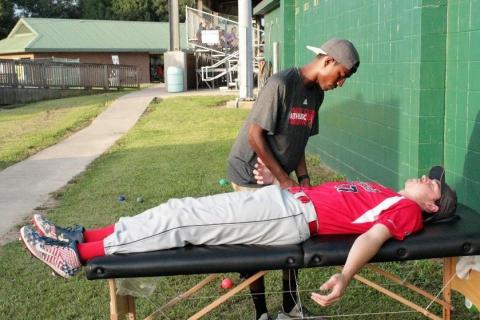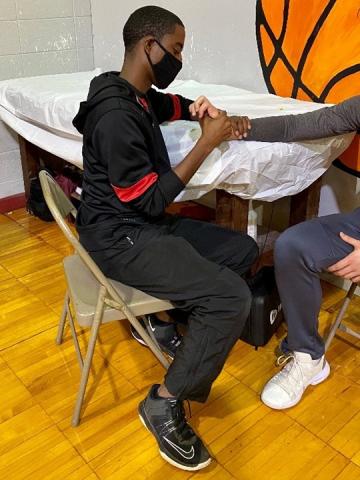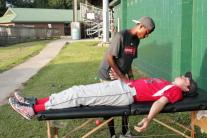News pages, sports websites, TV shows, and cinema screens are littered with concussion talk.
Athletic Training Alumni Spotlight: Christian Robertson
Fri, 02/26/2021 - 8:39amMeet Christian Robertson, MHA, LAT, ATC
For Christian Robertson ’12, a career in athletic training means every day brings new challenges and new opportunities to positively impact the lives of his student athletes.
He spoke with us about his role as the athletic trainer for Vermillion Catholic High School and the lasting connections he made during his time at the School of Kinesiology.
Why did you choose to become an athletic trainer?
It’s a funny story, actually. Take it back to my 7th grade year when my English teacher at the time assigned my class a career research paper. It was a no-brainer to me that I was obviously going play in the NBA. My teacher went on to tell me, “There are thousands of little boys just like you who want to go to the NBA. So, statistically, your odds aren’t that great”. She went on to tell me about physical therapists and how they work with athletes. I told her, “I’ll write it on this, but I’m still going to the NBA”. While researching Physical Therapy, I came across Athletic Training and loved how it was a career in healthcare AND sports. Safe to say, I did not go to the NBA, and here we are.

What is a typical day like for you?
During Covid, nothing has been very typical per-say, however ATs are used to that aspect of the career. It makes things interesting. For me though, I work in the secondary school setting. I arrive near the end of the school day before practice. During this time, I would review and document athlete injury notes, check in with the coach to get any schedule changes or an overview of the day, evaluate any new injuries, do pre-practice treatment or rehabilitation with anyone who’s currently injured, or tape anyone who needs it. Once practice begins, I am observing and prepared to provide care that can be as simple as cleaning a cut or splinting a broken wrist. That is on the most typical day. There are usually a lot of wrenches thrown into the mix though. But I love it, it keeps me on my toes!
What is your favorite part of your job?

My absolute favorite part is being able to connect with young athletes. I think the high school age is such a pivotal point in time and I want to do my part in being a positive role model for them as best as I can. You really get to know someone when you are walking with them through an injury. Those days can be quite hard for someone, but I like to think that when they walk into the athletic training room, they feel a little more encouraged. I think providing healthcare is the perfect way to make that impact. Also, I enjoy the spontaneous vibe in this sector of healthcare. You never know what injury you are going to get or have to provide care for. Anytime I’m running to an on-field injury, I sometimes think of those slow motion “Bay Watch” runs. Hopefully, I’m running faster than that though. It’s a rush.
What advice would you give someone who is interested in pursuing a career in athletic training?
I love this question because every athletic trainer would say something different. For me, I always like to tell people to really think about their “why” for choosing this profession. I find that the core reason I am in this career helps me through those tough days where I may not feel the most confident. I also like to tell people that there are many different settings an athletic trainer can work in. If you say, “well, I don’t really want to be in schools, so I don’t want to do it”. The great thing is that ATs have such a wide skill set within sports medicine that they can work in outpatient clinics, hospitals, airlines, teach, or even work at Amazon. It is such a dynamic career.
What did you most enjoy about your time at UL Lafayette?
Once we started the clinical program, I loved how my classmates and I were like a family. We had nearly every class together from very early in our college career. Now, 9 years later, I still work alongside them when our teams face each-other for a game or something like that. Also, every preceptor I spent time with, I can text or call them to this day, and they continue to provide mentorship for me. That means a lot to me and it is very beneficial for a healthcare provider who will experience so many different scenarios in the field.
Beginning in 2022, a master’s degree will be required by the Commission on Accreditation of Athletic Training Education and the National Athletic Trainers’ Association to gain national certification as an athletic trainer. The athletic training master’s degree program at UL Lafayette will provide you with multiple clinical experiences working alongside a certified athletic trainer to prepare you to work in high school sports, in clinics, and in industry.
Learn more about the Master of Science in Athletic Training program →

